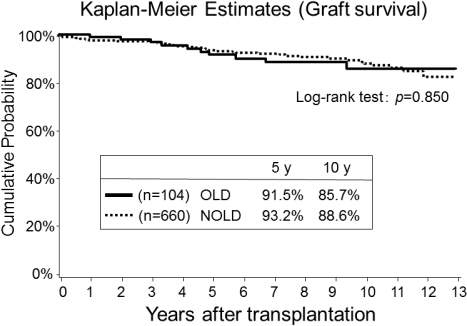Outcome of Kidney Transplantation from Obese Living Donors: Histological Evaluation Using Zero-Time Biopsy Specimens
1Department of Urology, Tokyo Women's Medical University, Tokyo, Japan
2Department of Pathology, Tokyo Women's Medical University, Tokyo, Japan
3Department of Pathology, St. Marianna University, School of Medicine, Kawasaki, Japan.
Meeting: 2015 American Transplant Congress
Abstract number: B197
Keywords: Graft survival, Histology, Nephrectomy, Obesity
Session Information
Session Name: Poster Session B: Living Donor Issues 1
Session Type: Poster Session
Date: Sunday, May 3, 2015
Session Time: 5:30pm-6:30pm
 Presentation Time: 5:30pm-6:30pm
Presentation Time: 5:30pm-6:30pm
Location: Exhibit Hall E
BACKGROUND AND OBJECTIVE: The relationship between preimplantation biopsy and graft outcome in kidney transplantation from obese living donors has not been studied. We reviewed graft outcomes and histological evaluation of zero-time biopsy specimens in kidney transplantation from obese living donors.
METHODS: We retrospectively evaluated 764 consecutive recipients at our institute. The subjects in the recipient cohort were stratified according to donor body mass index (BMI) as follows: obese living donors (OLD: BMI ≥ 25 kg/m2) and non-obese living donors (NOLD: BMI < 25 kg/m2). Histological evaluation results of zero-time biopsy specimens, early posttransplantation outcomes, patient survival, and graft survival were compared. Histological changes in each evaluated component of the kidney tissue were scored from 0 to 3.
RESULTS: Of the 764 kidney transplantations, 104 were OLDs (mean BMI: 26.4 ± 1.4 kg/m2) and 660 were NOLDs (mean BMI: 21.6 ± 2.0 kg/m2). In the histological evaluations, the scores for hyalinosis and tubular atrophy, but not for glomeruli and connective tissue, in the OLDs were significantly higher than those in the NOLDs. No significant differences were found between the 2 groups regarding incidences of acute graft rejection and slow graft function. Although significant differences in histological score were observed in the zero-time biopsy specimens between the OLDs and NOLDs, no significant differences in graft survival rate were observed between the 2 groups (Figure 1).
CONCLUSIONS: In the zero-time biopsies, the kidneys from the OLDs had histological problems compared with those from the NOLDs. However, the long-term graft survival rate in the patients with OLDs was similar to that of the patients with NOLDs. These results may indicate the criteria for utilization of OLDs, which should be considered when determining the appropriate donor.
To cite this abstract in AMA style:
Omoto K, Toki D, Okumi M, Shimizu T, Ishida H, Honda K, Koike J, Tanabe K. Outcome of Kidney Transplantation from Obese Living Donors: Histological Evaluation Using Zero-Time Biopsy Specimens [abstract]. Am J Transplant. 2015; 15 (suppl 3). https://atcmeetingabstracts.com/abstract/outcome-of-kidney-transplantation-from-obese-living-donors-histological-evaluation-using-zero-time-biopsy-specimens/. Accessed December 24, 2025.« Back to 2015 American Transplant Congress
